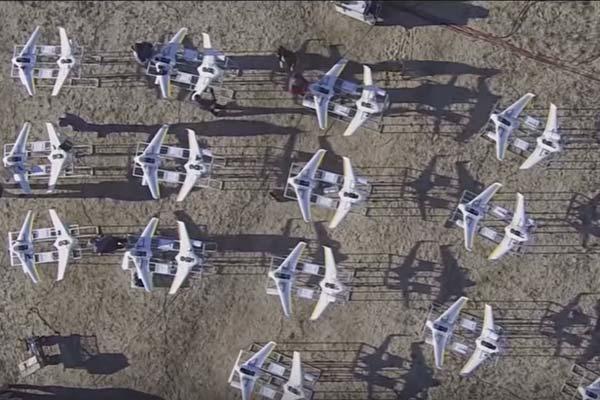The Navy will launch its first at-sea "air show" of dozens of drones swarming in formation late next month, officials with the Office of Naval Research said Friday.
The demo will feature more than 30 Raytheon-built Coyote unmanned aircraft systems launched in rapid succession and flying in formations, thanks to ONR's Low-Cost UAV Swarming Technology (LOCUST).
At $15,000 per unit, the drones are cheap enough to be expendable if needed and, launched at high numbers, they can overwhelm enemy forces while requiring little human supervision.
ONR wrapped up a series of land tests this week with an experiment at Yuma Proving Ground, Arizona, where 31 of the 12-14 pound Coyotes were tube-launched in approximately 40 seconds and proceeded to conduct a series of swarm formations and maneuvers, Vice Adm. Rick Breckenridge, deputy commander of U.S. Fleet Forces Command, told an audience at the Pentagon on Friday.
"It's going to change some of the calculus of how we operate," Breckenridge said of the technology.
Lee Mastroianni, ONR's program manager for LOCUST, told Military.com that the at-sea demonstration would take place off the East Coast, with the swarm of UAVs launched from the Sea Fighter, a small-waterplane-area twin-hull platform used by ONR for experimentation and research.
"We'll launch large numbers of them, doing swarm operations, flying around, doing a number of different flight profiles, then doing a land recovery," Mastroianni said. "We're flying them in different flight configurations where they're in very tight, and then they're going to change the relationship they all are to one another."
The swarming technology allows the drones to relate to each other spatially and fly their swarm formations with minimal human direction or intervention, which Mastroianni noted is key for practical and efficient unmanned technology that decreases the warfighter's burden.
"We have an operator that's monitoring it, keeping eyes on what's going on, and can reach in and change things if they want to," he said. "But the reality is, [the drones are] flying themselves, they're performing their mission and the operator's supervisory. So it tremendously reduces the workload to be able to control large numbers of UAVs."
The swarm can expend enemy resources by drawing fire or safely conduct tasks such as intelligence-gathering or jamming communications that might otherwise be accomplished with manned aircraft.
Mastroianni said he plans to recover all the Coyote UASs used in next month's demonstration so he can refurbish and re-use the drones for future tests and to avoid having to send divers into the Atlantic Ocean to recover them.
But officials have said they hope to drive the unit costs even lower -- to $10,000 or below -- to make them even easier to expend if needed.
Following the demo, Mastroianni said he expects ONR to announce its outcome and to incorporate findings and lessons learned in future testing. He said officials plan to continue development on the capability of the swarming drones to conduct maneuvers across the battlespace.
"As we come to a close on this chapter, we'll be exploring all those different things," he said. "I expect to be busy for quite a few years."
-- Hope Hodge Seck can be reached at hope.seck@military.com. Follow her on Twitter at@HopeSeck.

























